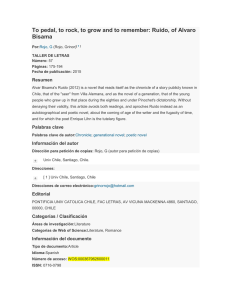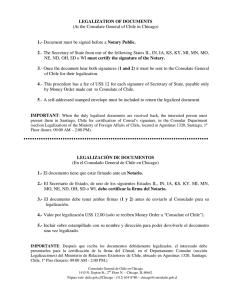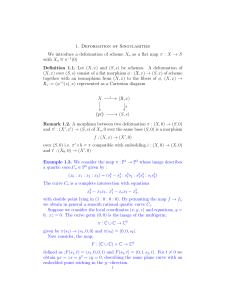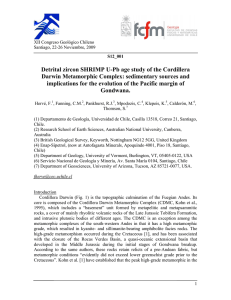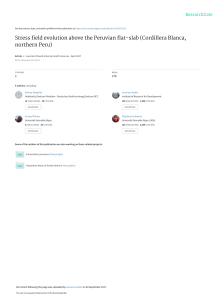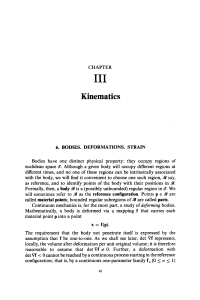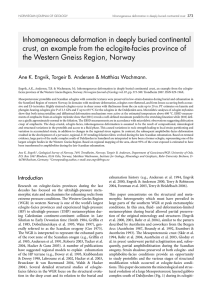Tectonic Setting of Andean IOCG deposits: Upper crustal strike
Anuncio
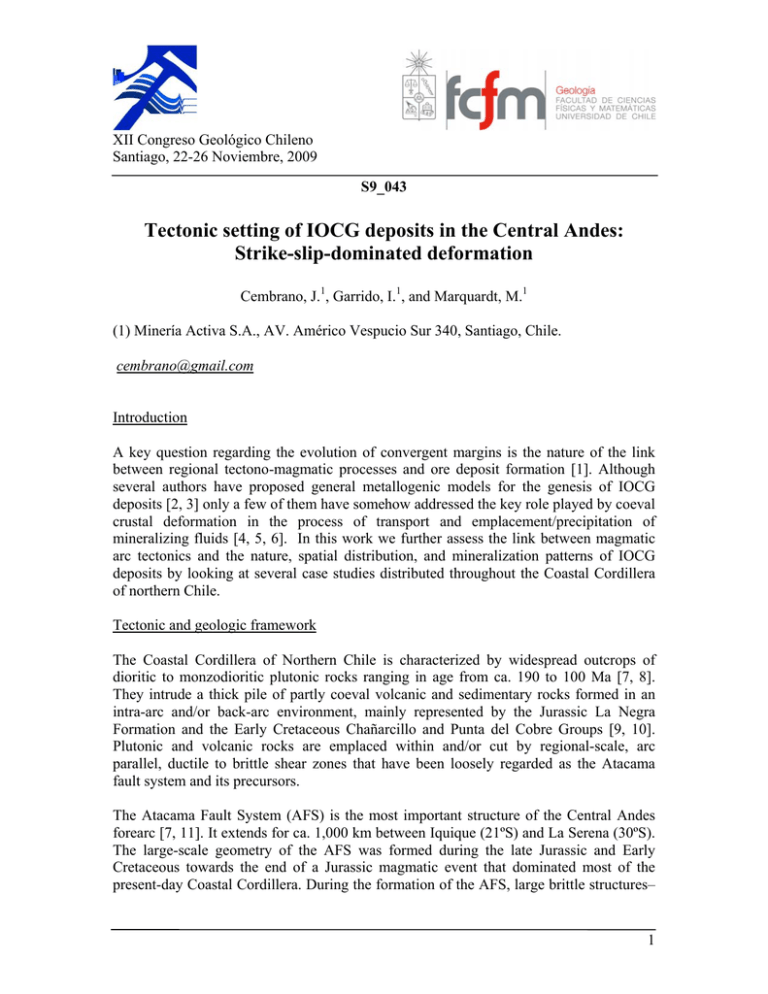
XII Congreso Geológico Chileno Santiago, 22-26 Noviembre, 2009 S9_043 Tectonic setting of IOCG deposits in the Central Andes: Strike-slip-dominated deformation Cembrano, J.1, Garrido, I.1, and Marquardt, M.1 (1) Minería Activa S.A., AV. Américo Vespucio Sur 340, Santiago, Chile. cembrano@gmail.com Introduction A key question regarding the evolution of convergent margins is the nature of the link between regional tectono-magmatic processes and ore deposit formation [1]. Although several authors have proposed general metallogenic models for the genesis of IOCG deposits [2, 3] only a few of them have somehow addressed the key role played by coeval crustal deformation in the process of transport and emplacement/precipitation of mineralizing fluids [4, 5, 6]. In this work we further assess the link between magmatic arc tectonics and the nature, spatial distribution, and mineralization patterns of IOCG deposits by looking at several case studies distributed throughout the Coastal Cordillera of northern Chile. Tectonic and geologic framework The Coastal Cordillera of Northern Chile is characterized by widespread outcrops of dioritic to monzodioritic plutonic rocks ranging in age from ca. 190 to 100 Ma [7, 8]. They intrude a thick pile of partly coeval volcanic and sedimentary rocks formed in an intra-arc and/or back-arc environment, mainly represented by the Jurassic La Negra Formation and the Early Cretaceous Chañarcillo and Punta del Cobre Groups [9, 10]. Plutonic and volcanic rocks are emplaced within and/or cut by regional-scale, arc parallel, ductile to brittle shear zones that have been loosely regarded as the Atacama fault system and its precursors. The Atacama Fault System (AFS) is the most important structure of the Central Andes forearc [7, 11]. It extends for ca. 1,000 km between Iquique (21ºS) and La Serena (30ºS). The large-scale geometry of the AFS was formed during the late Jurassic and Early Cretaceous towards the end of a Jurassic magmatic event that dominated most of the present-day Coastal Cordillera. During the formation of the AFS, large brittle structures– 1 XII Congreso Geológico Chileno Santiago, 22-26 Noviembre, 2009 more than 60 km in length– were formed by sinistral strike-slip movements [12, 13]. Some of the NS-striking master faults and subsidiary NW-striking splay faults are organized into strike-slip duplexes that occur at various scales from regional to local [14, 15]. The geometry, kinematics and timing of deformation of the AFS are well known at the regional-scale [7, 8, 11, 13, 14]. Although the kinematics and timing of deformation varies along-strike, most authors agree that intra-arc sinistral transtensional to sinistral transpressional deformation occurred during arc construction at least from 160 to 110 Ma along most of the present-day Coastal Cordillera from Antofagasta to Vallenar. Absolute age determinations of ductile deformation document coeval sinistral and dip-slip normal displacement at around 130 Ma and sinistral displacement around 125 Ma [7, 8, 16]. Strike-slip tectonics, coeval with arc magmatism during the Late Jurassic–Early Cretaceous, has been attributed to highly oblique subduction and strong plate coupling following an increase in plate convergence rate. The Atacama Fault system sensu stricto started at ca. 125 Ma when arc magmatism ceased at the present-day Coastal Cordillera and progressive cooling led to more localized, sinistral strike-slip brittle deformation expressed as NS and NW-striking fault networks. Tectonics and mineralization IOCG deposits throughout the Coastal Cordillera of northern Chile from Taltal to La Serena share a remarkable structural pattern: they almost invariable occur in close spatial and temporal association with NNW to WNW-striking sinistral strike-slip fault zones (e.g. Candelaria, Carola, Manto Verde, Teresa de Colmo) with only a few occurrences along NE-trending structures (e.g. Cerro Negro). Most of the NW-striking structures can be regarded as second-order faults splaying off the margin-parallel master faults of the AFS. However, a significant number of these faults are kinematically unrelated to the AFS, showing evidence of long-lived displacement that pre-dates and outlasts that of the AFS [8]. Iron-oxides and copper sulphides/oxides ore bodies consist of massive/banded veins and mantos, hydrothermal breccia bodies, and vein-parallel striated brittle faults. As a whole they form a structural mesh of primary and secondary discontinuities hosting variable amounts of copper ore [17]. Kinematic indicators within the NW-striking fault-veinbreccia systems in most -if not all- of the IOCG deposits of the Coastal Cordillera of northern Chile, suggest that mineralization was concomitant with sinistral and sinistraltranstension [4, 5, 18, 19, 20]. 2 XII Congreso Geológico Chileno Santiago, 22-26 Noviembre, 2009 The model IOCG deposits in the Coastal Cordillera of northern Chile are closely spatially and temporally associated with the transition from intra-arc ductile to brittle sinistral deformation at ca. 124 Ma with a peak at about 118 to 105 Ma [18, 21, 22]. Cu-bearing hydrothermal fluids associated with locally high-K magmatism channelled through NNW and NW-trending old and newly created fractures that acted as Riedel shears and tension cracks within an overall sinistral, NNE-trending, deforming arc-system. Some regionalscale Riedel shears seem to sole out from the Central Valley shear zone, a belt of transpressional deformation, east of the AFS, which was active from ∼110 to 80 Ma. Both Riedel shears and tension fractures not only served as channel-ways for fluid migration but may have triggered episodic mineral precipitation either by fluid pressure fluctuation and/or by mixing between fluids from different sources (e.g. basinal, magmatic, meteoric). The process of IOCG mineralization likely occurred under progressively more brittle conditions representing the last stages of hydrothermal activity associated with a waning magmatic arc in the present-day Coastal Cordillera at ca.110 Ma. References [1] Richards, J., Boyce, A., Pringle, M. (2001) Geologic evolution of the Escondida area, northern Chile: a model for spatial and temporal localization of porphyry Cu mineralization. Economic Geology, vol. 96, 271-305. [2] Barton, M., Johnson, D. (1996) Evaporitic-source model for igneous-related Fe oxide-(REECu-Au-U) mineralization. Geology vol. 24, 259-262. [3] Hitzman, M. (2000) Iron Oxide-Cu-Au Deposits: What, Where, When, and Why; in Porter, T.M. (Ed.). Hydrotermal Iron Oxide Copper-Gold y Related Deposits: A Global Perspective, Australian Mineral Foundation, Adelaide, 9-25. [4] Bonson, C., Grocott, J., Rankin, A. (1997) A structural model for the development of Fe-Cu mineralization Coastal Cordillera, Northern Chile (25º15´-27º15´). VIII Congreso Geológico Chileno 1997, vol. III, 1608. [5] Sanhueza, A., Robles, W., Cembrano, J., Orrego, M., Pavez, A. (2000) Origen tardimagmático de la magnetita en el distrito Manto Verde y su asociación a magmatismo sintectónico y exhumación rápida en un duplex extensional de la Zona de Falla de Atacama. Actas del IX Congreso Geológico Chileno, Puerto Varas, vol. II, 161. [6] Arevalo, C., Grocott, J., Martin, W., Pringle, M., Taylor, G. (2006) Structural Setting of the Candelaria Fe Oxide Cu-Au Deposit, Chilean Andes (27º30' S). Economic Geology, vol. 101, 1– 24. [7] Scheuber, E.,Gonzales, G. (1999) Tectonics of the Jurassic-Early Cretaceous magmatic arc of the north Chilean Coastal Cordillera (22°-26°S): A story of crustal deformation along a convergent plate boundary. Tectonics, vol. 18, 895-910. 3 XII Congreso Geológico Chileno Santiago, 22-26 Noviembre, 2009 [8] Grocott, J., Taylor, G. (2002) Magmatic arc fault systems, deformation partitioning and emplacement of granitic complexes in the Coastal Cordillera, north Chilean Andes (25°30´S to 27°00´S). Journal of the Geological Society, London, vol. 159, 425-442. [9] Godoy, E.,Lara, L. (1998) Hojas Chañaral y Diego de Almagro, Región de Atacama. Servicio Nacional de Geología y Minería, Mapas Geológicos N. 5-6, 1 mapa escala 1:100.000, Santiago. [10] Oliveros, V. (2005) Étude geochronologique des unités jurassiques et Crétacé Inférieur du Nord du Chili (18º30'-24ºS, 60º30'-70º30'W): Origine, mise en place, altération, métamorphisme et minéralisations associées. Thesis, Université de Nice-Sophia Antipolis and Departamento de Geología, Universidad de Chile, Santiago, p. 305. [11] Brown, M.; Diaz, F., Grocott, J. (1993) Displacement History of the Atacama Fault System, 25°-27°S, Northern Chile. Geological Society of American Bulletin, vol. 105, 1165-1174. [12] Hervé, M. (1987) Movimiento sinistral en el Cretácico Inferior de la Zona de Falla de Atacama al norte de Paposo (24ºS), Chile. Revista Geológica de Chile, vol. 31, 37-42. [13] Scheuber, E., Andriessen, P. (1990) The kinematic and geodynamic significance of the Atacama fault zone, northern Chile. Journal of Structural Geology, vol. 12, 243-257. [14] Taylor, G.K.; Grocott, J.; Pope, A., Randall, D.E. (1998) Mesozoic fault systems, deformation and fault block rotation in the Andean forearc: a crustal scale strike-slip duplex in the Coastal Cordillera of northern Chile. Tectonophysics, vol. 299, 93-109. [15] Cembrano, J., González, G., Arancibia, G., Ahumada, I. Olivares, V., Herrera, V. (2005) Fault zone development and strain partitioning in an extensional strike-slip duplex: A case study from the Mesozoic Atacama fault system. Tectonophysics, vol. 400, 105-125. [16] Scheuber, E., Hammerschmidt, K., Friedrichsen, H. (1995) 40Ar –39Ar and Rb–Sr analyses from ductile shear zones from the Atacama fault zone, northern Chile: the age of deformation. Tectonophysics, vol. 250, 61–87. [17] Sibson, R. H. (1996) Structural permeability of fluid-driven faultfracture meshes: Journal of Structural Geology, vol. 18, 1031–1042. [18] Vila, T., Lindsay, N., Zamora, R., (1996) Geology of the Mantoverde copper deposit, northern Chile: A specularite-rich hydrothermal-tectonic breccias related to the Atacama fault zone: Society of Economic Geologists Special Publication 5, p. 157–170. [19] Correa, A. (2000) Geología del yacimiento de Fe-Cu Teresa de Colmo, Región de Antofagasta, Chile. Actas 9th Congreso Geológico Chileno, vol. 2, 102–106. [20] Orrego M, Zamora R (1991) Manto Ruso, un yacimiento de cobre ligado a la Falla de Atacama, norte de Chile. Actas 6th Congreso Geológico Chileno, vol. 1, 174–178. [21] Mathur, R., Marschik, R., Ruiz, J., Munizaga, F., Leveille, R.A., Martin, W. (2002) Age of mineralization of the Candelaria Fe oxide Cu-Au deposit and the origin of the Chilean iron belt, based on Re-Os isotopes. Economic Geology, vol. 97, 59–71. [22] Pop, N., Heaman, L., Edelstein, O., Isache, C., Zentilli, M., Pecskay, Z., Valdman, S., Rusu, C. (2000) Geocronología de las rocas ígneas y los productos de alteración hidrotermal relacionadas con la mineralización de Cu-Fe (Au) del sector Adriana-Carola-Cobriza (parte este del distrito Punta del Cobre-Candelaria), en base a dataciones U-Pb en circo´ n, 40Ar/39Ar y KAr. Actas 9th Congreso Geológico Chileno, vol. 2, 155–160. 4



